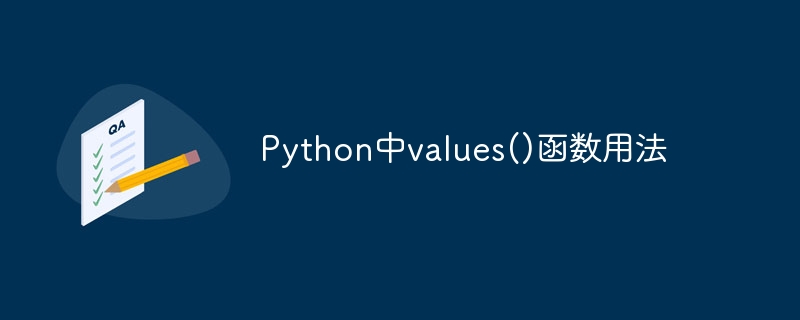

Usage of values() function in Python
In Python, dictionary is a commonly used data structure used to store key-value pairs. When working with dictionaries, we often need to get all the values in the dictionary. Python provides a built-in function values() that can be used to return all values in the dictionary. This article will introduce the usage of values() function in detail and provide specific code examples.
The syntax of the values() function is as follows:
dict.values()
This function does not receive any parameters and can be called directly. It returns a view object containing all the values in the dictionary. This view object can be used to iterate over all values, or convert them to a list or other collection.
The following is some sample code using the values() function.
Example 1: Iterate over all values in the dictionary
student_scores = {'Alice': 90, 'Bob': 80, 'Cathy': 95}
for score in student_scores.values():
print(score)
# 输出结果:
# 90
# 80
# 95In this example, we create a dictionary student_scores to store students' grades. By calling the values() function, we can iterate over all the values in the dictionary and print them out one after another.
Example 2: Use the in keyword to check whether a certain value exists in the dictionary
student_scores = {'Alice': 90, 'Bob': 80, 'Cathy': 95}
if 80 in student_scores.values():
print("Bob的成绩为80分")
# 输出结果:
# Bob的成绩为80分In this example, we use the values() function to convert the values in the dictionary into a set, and then Use the in keyword to check if 80 exists in the set. Since Bob's score is 80 points, the condition is established and the corresponding prompt information is printed.
Example 3: Convert the view object returned by the values() function into a list
student_scores = {'Alice': 90, 'Bob': 80, 'Cathy': 95}
score_list = list(student_scores.values())
print(score_list)
# 输出结果:
# [90, 80, 95]In this example, we use the list() function to convert the view object returned by the values() function into a list. In this way, we can easily perform further operations on the list, such as sorting, slicing, etc.
Summary:
The values() function is an important function in Python for obtaining all values in the dictionary. It can return a view object that can iterate over all values or convert them into other forms of collections. In practical applications, we often need to use the values() function to process values in the dictionary, which makes it easier to operate and process data.
The above is the detailed content of How to use the values() method in Python. For more information, please follow other related articles on the PHP Chinese website!
 setInterval
setInterval
 What is the shortcut key for brush size?
What is the shortcut key for brush size?
 Detailed explanation of linux dd command
Detailed explanation of linux dd command
 How to solve disk parameter errors
How to solve disk parameter errors
 What are the SEO diagnostic methods?
What are the SEO diagnostic methods?
 What are the css3 gradient properties?
What are the css3 gradient properties?
 The most promising coin in 2024
The most promising coin in 2024
 What does pycharm mean when running in parallel?
What does pycharm mean when running in parallel?
 The difference between PD fast charging and general fast charging
The difference between PD fast charging and general fast charging




